Re-designing Universities: Social Learning Space
The symposium 'Re-designing Universities: social learning space' was jointly hosted by The Reinvention Centre and Oxford Brookes University's ASKe (Assessment Knowledge Standards exchange) CETL on the 26th of January 2006 at Oxford Brookes.
(Assessment Knowledge Standards exchange) CETL on the 26th of January 2006 at Oxford Brookes.
The facilitators of the discussion groups held in the afternoon of the event provided the following summaries:
Berry O'Donovan - (a Deputy Director of ASKe)
Chris Rust - (the Deputy Director of the Reinvention Centre and a Deputy Director of ASKe)
Jude Carroll - (a Deputy Director of ASKe)
Margaret Price - (Director of ASKe)
Marion Temple - (the former Deputy Director of the Reinvention Centre)
Introduction by Chris Rust
(Deputy Director of the Reinvention Centre and a Deputy Director of ASKe)
In UK universities especially, space has tended to be designated for very specific purposes. Lecture theatres are for lectures, classrooms are for seminars, refectories are places to eat, libraries are places where you are quiet and work on your own. With an increased focus on student centred collaborative learning, there has been a growing recognition that these spaces are not either adequate or appropriate.
Social learning space is a relatively new idea, and covers quite a wide range of possibilities. At one end of that range is space that is used primarily for social activities, but where some learning might also take place – an internet café, for example. At the other end of the spectrum there is space which takes account of the fact that learning often requires social interaction, and is designed accordingly – flat rooms, movable furniture, etc. – as opposed to a tiered lecture theatre. But within that range, one general definition of social learning space might be 'a physical and/or virtual area that is not predominantly identified with either social or work/study perspectives but transcends both and facilitates both formal and informal student centred collaborative learning' (Oldenburg, 1991, cited in Williamson & Nodder, 2002). Spaces that combine: social activities (e.g. eating and drinking, getting to know people, staying in touch with people, hanging out in groups); learning (e.g. studying with others, group project work, meeting with advisors) and technology (e.g. writing, editing, printing, on-line research, e-mail, on-line discussion, on-line workshops/collaboration, socialising on-line and perhaps even playing games).
All of this is heavily influenced by a social-constructivist view of learning (Vygotsky, 1962, 1978; Bruner, 1986, 1990) that students need the stimulus of interaction with each other, in social groups, to construct their learning. Consequently, their contact with each other outside the classroom is often where they learn the most, and the importance of this type of learning is increasingly being recognised (in part due to the rapid advances in technology, in part due to reduced contact time and, some writers suggest, because current students are less attuned to knowledge delivery/lecture modes of teaching).
The Reinvention Centre is especially interested in this area. The Reinvention Centre at Brookes is currently in the process of developing a dedicated social learning space, and at Warwick University, which is the lead partner, there is a well established social learning space called The Learning Grid and further developments are in the pipeline. At Brookes there is also ASKe, based in the Business School, which is committed to a new building based around the concept of social learning space. In addition, there is also a small, first attempt at providing such a space centrally in the 'Eights coffee lounge' which has only recently been opened.
and further developments are in the pipeline. At Brookes there is also ASKe, based in the Business School, which is committed to a new building based around the concept of social learning space. In addition, there is also a small, first attempt at providing such a space centrally in the 'Eights coffee lounge' which has only recently been opened.
The first symposium on 'Re-designing Universities: social learning space' was held at Brookes in January this year and it is planned that it will be an annual event.
References:
Bruner, J (1986) Actual minds, possible worlds, Cambridge, MA, Harvard University Press
Bruner, J (1990) Acts of meaning, Cambridge, MA, Harvard University Press
Vygotsky, L. (1962) Thought and language, Cambridge, MA, MIT Press
Vygotsky, L. (1978) Mind in society: the development of higher psychological processes, Cambridge, MA, Harvard University Press
Williamson, A. & Nodder, C. (2002) "Extending the learning space: dialogue and reflection in the virtual coffee shop". Computers and Society, 32 (3) ACM SIGCAS
Format of the Event
10.30 Welcome - Rex Knight, Deputy VC and Registrar, Oxford Brookes University

Rex Knight, Deputy VC and Registrar
10.40 Keynote speaker – Professor Anja Timm, University of Lancaster

Professor Anja Timm, University of Lancaster
Current example:
11.30 Warwick Learning Grid – Rachel Edwards, Learning Grid Manager, Warwick University
Future examples at Brookes:
11.50 Reinvention Centre – Marion Temple, [now former] Deputy Director, Reinvention Centre

Marion Temple being presented with flowers by Chris Rust on behalf of the Reinvention Centre team as a token of appreciation for all of her hard work
12.10 ASKe Building (and Eights Café Lounge) - Berry O’Donovan, Deputy Director, ASKe
12.30 Lunch
1.15 General discussion groups (A)
What are the implications? How can we change existing spaces? How can we make these new spaces work? How do students study now?
2.15 Afternoon tea/coffee
2.30 Discussion Focus Groups (B)
3.30 Plenary
4.15 End


Please click on the above image to see a larger version


Please click on the above image to see a larger version
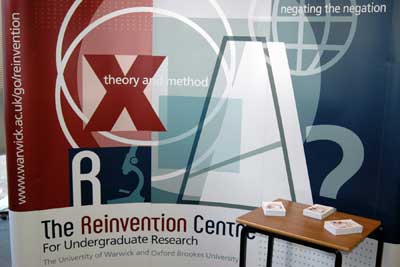
Discussion Group Summaries
Berry O'Donovan, a Deputy Director of ASKe
Overarching issues:
We don't really know how students study; we need more data on this - time, role of the library, space usage, etc.
We discussed how much we should manipulate this process and the balance between control, flexibility and freedom (opinions varied on this, I thought our facilitation role meant that we could be supportively manipulative, others thought it infringed student autonomy).
The issues around student study habits and space were much wider than space - should we get involved in nutrition, for instance, as well as more 'usual' student support services?
Students: how they study
Our students said that they frequently did study through to the early hours of the morning and that to be effective such spaces must be open 24/7, which raised security issues that took up a lot of our discussion time.
Students in the discussion did favour small, enclosed spaces (contrary to what we have learnt from other spaces) and wanted bookable spaces.
Students on the whole were quite reticent on how they studied. But vocal on the fact they did not have appropriate spaces to do so. Students showed a surprising reliance on 'text books' as sources of information - so the library was still valued, but this is a small sample and I am conscious of not wanting the opinions of three students to set future directions.
Surprisingly, students wanted a real rational/economic focus - a cost/benefit analysis. But they were business students!
Students were very happy with self-policing - if it's your mess you clean it up.


Chris Rust, the Deputy Director of the Reinvention Centre and a Deputy Director of ASKe
Are there at least three kinds of space?
- ‘Service-needs’ or dedicated space, e.g. lecture halls
- Flexible space – multiple possible uses (some defined, some by choice)
- ‘Fusion’ space– must compete with Coffee Republic, Blackwells, etc. (students choose to be there)
Are there tensions between desired pedagogy and resource constraints?
How do we determine how much of each space we want and/or can afford?
There is a need for appropriate space to make teamwork easier and, in turn, to help improve student perception of it. Need to change pedagogy to change student behaviour to encourage collaborative working.
Opening times need to be considered carefully; the day may not be the best time - students may want to work through evening into at least early morning.
If this is the case, couldn't existing teaching rooms be made available as they won't be being used at those times? Is booking necessary? If so, could current bureaucracy be lightened?
Bigger issue than just space. Need to have the rest of the infrastructure to support it. Need coordination between Library/IT/AV etc. Is there tension between creating 24/7 facilities and encouraging work/life balance?
Can the development of the use of these spaces be engineered or does it need to be organic? There are important issues of both values and trust.
The ‘new’ spaces at Brookes should be seen as pilots. They can only accommodate limited numbers and more spaces will need to be developed. In this pilot phase we should be prepared to take risks and possibly fail.

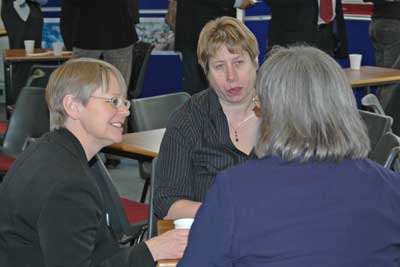
Jude Carroll, a Deputy Director of ASKe
Group A
1. Attraction factors:
• Space:
1. Colour
2. Noise Control
3. “Sticking” factors e.g. moving from coffee to study? Parking in the evening, Commitment, Lockers and Security.
4. Social including celebration
5. Visible activity – watching others work
6. Continuity with other spaces: what happens next door
7. Who owns the space?
8. Balancing mess and order
• Time
• Discipline specific resources / socializing might be necessary and special
2. University as just one aspect of student life:
• Redesigning modules to force social learning so students have to be together
• Students doing research along side students:
1. Students contributing data
2. Students designing seminars
3. Creating interaction
4. Students do not perceive lack of interaction as a loss
• Flexible working
• Using Eights for a range of things?
3. Values:
• Sustainability
• Encountering staff as people – “the space wouldn't work if academics couldn't feel okay there too”
• Ownership – student-owned creates divisions that you don't want because students don't all use the same space
• What’s the purpose of all Universities? – Jobs: Newman: Research: Learn, grow and develop.
• What’s the purpose of this University?
• Taking risks, enjoyment and fun
Group B
1. Stuff about ASKe and Reinvention Centre fittings and place
• Wired and wireless
• Luring people to spend time at Wheatley through late night opening, cheap food, parking, no rebooking hurdles, safety
2. Ensuring that Brookes learns from the first two experiments
• Systematic, careful, attentive data collection
• Arguing through the relative importance of priorities at the different Brookes campuses – we need more flexible design in reproducing what we now have so as to reconfigure it in the next iteration
• Balancing the claims of specialist discipline specific work against generic spaces in order to create a rich interaction
3. Pedagogy led change process
Enhancing teachers experiences and purposes through more engagement, more time on the task and more interaction
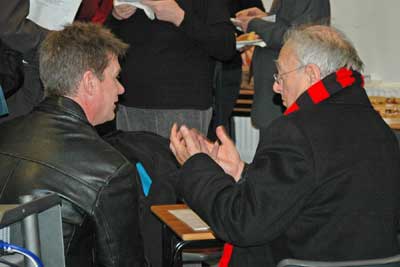
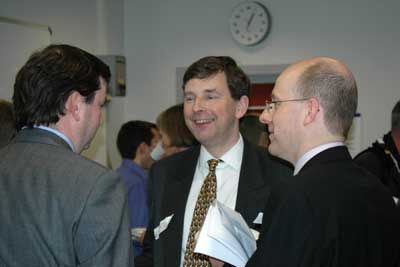
Margaret Price, Director of ASKe
Group A
• Drivers for change are forcing universities to rethink usage of space, e.g. changing wants and needs of more diverse multicultural student body, e.g. university bars are less popular, with greater demand for social spaces without alcohol.
• To get the spaces right we need to engage architects who understand the changing nature of communal spaces where social learning is important, such as in businesses and universities.
• We need to recognise the need for consultation with potential users but also recognise the tension that consultation may bring. Consultation that requires the definition of space rather than ideas may not provide an impetus for risk and innovation. It was agreed that it was much easier to say what is not wanted than to be precise about what is required.
• Decisions cannot be taken without regard or recognition of other factors and sometimes conflicting interests, e.g. a commercial venture supplying food, may not be viable if all the visitors occupying the space take their own food.
• In deciding about the management of space we must first address ‘our’ views of students. To what extent do we assume a controlling role? To what extent do we trust all members of the university community to take responsibility for communal space?
• Should we locate these spaces on campus or should they be closer to the students' living areas? Would such space provide more of a heart to a campus?
• Recognise that not all students will choose social learning space, preferring libraries or off campus venues. We need to get the balance and provide choice.
• Consider how we can support students and staff to get the most out of ‘new’ spaces. A coaching model may be successful.
Group B
Setting up a Special Interest Group.
The group identified diverse missions for the social learning space being developed and these were linked to a range of pedagogies. Despite these differences it was felt that a SIG provided an opportunity to share and learn from experience of others.
Some developments were benefiting from CETL funding. It will be easier to fund research into the use and effect of these spaces for CETLs but this research should benefit other developments.
It was agreed that the SIG initially would function as a self-help group sharing information in relation to:
• Social learning space already in use
• Development and innovation in the use of space
• Ways of managing social learning space
• Pedagogies linked to space and its use.
If the group becomes well established it may seek funding to support further development but would wish to remain independent of another organisation.
It hoped to arrange a visit to see social learning spaces already operational at the University of Hertfordshire.
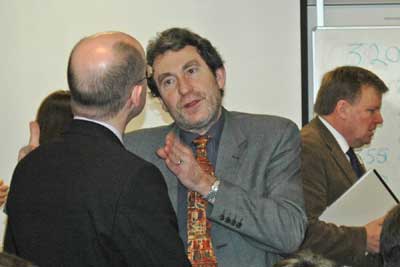
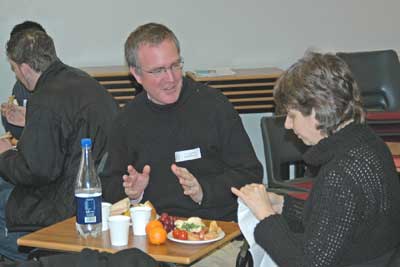
Marion Temple, the former Deputy Director of the Reinvention Centre
Group A
1. New Space
• Tension between success and pressure on the space.
• If student led, how can students be supported in using the space?
• Reduce teaching / research boundaries and don't create student / academic / support staff boundaries.
• Attract students in a non-classroom situation.
• How do we ensure the accessibility of diverse learning materials to support student learning in a single space?
2. Pedagogy
• Need to change curriculum in order to change teaching in order to change learning – important to think about curriculum.
• What do we mean by social learning space? Flexibility?
• Research the space and student learning.
Group B
• Where is collaborative learning happening? And how much collaborative learning is happening?
• Take advantage of the opportunity presented by the demolition of the Darcy building: the siting of the front door will be important: integrate support functions and student study.
• Provide flexibility, using a range of technology as an attractor.
• Provide a comfortable environment.
• Tension between School of the Built Environment space and generic space? Use the CETL space as a pilot resource and research, evaluate and monitor it.
